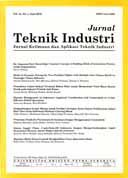Optimal Kiln Dry Allocation for Dry Timber Preparation to Minimize Cost
 :
:
https://doi.org/10.9744/jti.21.1.43-48
Keywords:
material planning, linear programming, wood-board manufacturingAbstract
Optimization models are increasingly developed for planning and scheduling in manufacturing of natural resources. However, the uncertainty of material from natural resources makes it more difficult to develop a model. In this paper, we concern about the cost of dry timber preparation for finishing process in a wood-board manufacturer. Based on characteristics of the material and wood-board production process, we develop two models to minimize transportation and drying cost of wood supply. The models consider the capacity of facilities, distances among facilities, and timber specification-based drying periods. The model is solved using linear programming, result in drying allocation of kiln dry’s chambers that gives the minimum cost of the process. A sensitivity analysis is conducted to demonstrate the effect of variation of internal capacity and external capacity to the objective function value. The results show that the total cost is more sensitive to the variation of the external capacity of kiln dry than the variation of the internal capacity.References
Komsiyah, S., Meiliana, Centika, H.E., 2018. A Fuzzy Goal Programming Model for Production Planning in Furniuter Company, Procedia Computer Science, 135, 544-552.
Robb D.J., Xie B., and Arthanari T., 2007, Supply Chain and Operations practice and Performance in Chinese Furniture Manufacturing, International Journal of Production Economics, 112, 683-699.
Michelsen, O., Fet., A.M., and Dahlsrud A., 2006, Eco-efficiency in Extended Supply Chains: A case study of furniture production, Journal of environmental management, 290-297.
Forget P., D’Amours S., and Frayret J-M., 2008, Multi-behavior Agent Model for Planning in Supply Chains: An application to the Lumber Industry, Robotics and Computer-Integrated manufacturing, 24, 664-679.
Gaudreault, J., Forget, P., Frayret, J.-M., Rousseau, A. and D'amours, S. 2011. Combined Planning and Scheduling in a Divergent Production System with Co-production: A Case Study in the Lumber Industry, Computers & Operations Research, 38, 1238-1250
Gaudreault, J., Frayret, J.-M., Rousseau, A. and D’amours, S. 2008. Combined Planning and Scheduling in a Divergent Production System with Co-Production. CIRRELT. Quebec, Canada: Universite Laval.
Marier, P., Gaudreault, J. and Noguer, T. 2016. Kiln Drying Operation Scheduling with Dynamic Composition of Loading Patterns. ILS Conference.
Maturana, S., Pizani, E. and Vera, J. 2010. Scheduling Production for a Sawmill: A Comparison of a Mathematical Model Versus a Heuristic. Computers & Industrial Engineering, 59, 667-674.
Wery, J., Gaudreault, J., Thomas, A. and Marier, P. 2018. Simulation-Optimisation Based Framework for Sales and Operations Planning Taking into Account New Product Opportunities in a Co-Production Context. Computers in Industry, 94, 41-51.
Ouhimmou, M., D’Amours, S., Beauregard, R., Ait-Kadi, D., and Chauhan S.S., 2008, Furniture Supply Chain Tactical Planning Optimization using a Time Decomposition Approach, European Journal of Operational Research, 189, 952-970
Downloads
Published
How to Cite
Issue
Section
License
Articles published in the Jurnal Teknik Industri: Jurnal Keilmuan dan Aplikasi Teknik Industri will be Open-Access articles distributed under the terms and conditions of the Creative Commons Attribution License (CC BY).
![]()
This work is licensed under a Creative Commons Attribution License (CC BY).



















